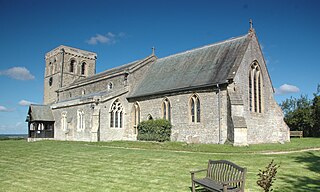
Garsington is a village and civil parish about 8 kilometres (5 mi) southeast of Oxford in Oxfordshire. "A History of the County of Oxfordshire" provides a detailed history of the parish from 1082. The 2011 census recorded the parish's population as 1,689. The village is known for the artistic colony and flamboyant social life of the Bloomsbury Group at Garsington Manor when it was the home from 1914 to 1928 of Philip and Ottoline Morrell, and for the Garsington Opera which was staged there from 1989 to 2010.

All Saints' Church, is in Childwall, Liverpool, England. It is recorded in the National Heritage List for England as a designated Grade I listed building, and is the only medieval church remaining in the Metropolitan borough of Liverpool. It is an active Anglican parish church in the diocese of Liverpool, the archdeaconry of Liverpool and the deanery of Liverpool South – Childwall.

Bodicote is a village and civil parish in North Oxfordshire, approximately 2 miles (3 km) south of the centre of Banbury. The 2011 Census recorded the parish's population as 2,126. The Church of England parish church of Saint John the Baptist is a Grade II* listed building, with the chancel arch dating back to the 13th century.

St Mary's Church is an active Anglican parish church located in Monk's Lane, Acton, a village to the west of Nantwich, Cheshire, England. Since 1967 it has been designated a Grade I listed building. A church has been present on this site since before the time of the Domesday Survey. The tower is the oldest in Cheshire, although it had to be largely rebuilt after it fell in 1757. One unusual feature of the interior of the church is that the old stone seating around its sides has been retained. In the south aisle are some ancient carved stones dating back to the Norman era. The architectural historian Alec Clifton-Taylor includes the church in his list of 'best' English parish churches. In the churchyard is a tall 17th-century sundial. The church is an active Anglican parish church in the diocese of Chester, the archdeaconry of Macclesfield and the deanery of Nantwich. Its benefice is united with those of St David, Wettenhall, St Oswald, Worleston, and St Bartholomew, Church Minshull.

St Helen Witton Church, Northwich, is in the centre of the town of Northwich, Cheshire, England. It is recorded in the National Heritage List for England as a designated Grade I listed building. The church is now known as "St Helen's, Witton" or "Northwich Parish Church". It is an active Anglican parish church in the diocese of Chester, the archdeaconry of Chester and the deanery of Middlewich. Alec Clifton-Taylor includes it in his list of 'best' English parish churches.

All Saints' Church is the parish church of Runcorn, Cheshire, England, sited on the south bank of the River Mersey overlooking Runcorn Gap. There is a tradition that the first church on the site was founded by Ethelfleda in 915. That was replaced, probably in about 1250, by a medieval church that was altered and extended in the 14th and 15th centuries. By the 19th century the building's structure had deteriorated and become dangerous, and it was replaced by a new church, built between 1847 and 1849 to the designs of Anthony Salvin.
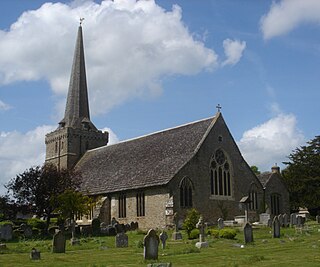
Holy Trinity Church is an Anglican church in the village of Cuckfield in the district of Mid Sussex; one of seven local government districts in the English county of West Sussex. It was founded in the 11th century and was in the possession of Lewes Priory by 1090. The present structure dates from the mid-13th century but was extended in the 14th century and heavily altered and restored during the Victorian period, with much interior work by Charles Eamer Kempe and stained glass by both Kempe and the Clayton and Bell firm. The church's spire was replaced in 1981 following a fire. Former chapels of ease in outlying hamlets have closed, and the church now serves a large rural area in the centre of Sussex. It is protected as a Grade I listed building.

Holy Trinity Church is a redundant Anglican church on Low Lane in the village of Wensley, North Yorkshire, England. The building is recorded in the National Heritage List for England as a designated Grade I listed building, and is under the care of the Churches Conservation Trust. Alec Clifton-Taylor included the church in his list of 'best' English parish churches.
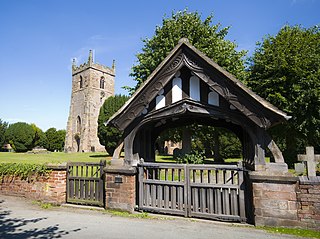
All Saints Church, Alrewas is a parish church in the village of Alrewas, Staffordshire in England. The church is situated in the north west of the village on the north side of the Trent & Mersey Canal. The church is a Grade I Listed Building. A church has stood on the current site since the 10th century. The current building was mainly built during the 13th, 14th, 16th and 19th centuries.

The Church of St Mary and All Saints is an Anglican church in the village of Whalley, Lancashire, England. It is an active parish church in the Diocese of Blackburn. A church probably existed on the site in Anglo-Saxon times and the current building dates from the 13th century. It is recorded in the National Heritage List for England as a designated Grade I listed building.
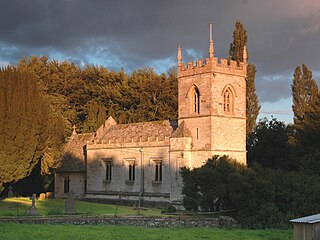
Westcott Barton, also spelt Wescot Barton or Wescote Barton, is a village and civil parish on the River Dorn in West Oxfordshire about 7 miles (11 km) east of Chipping Norton and about 9+1⁄2 miles (15 km) south of Banbury, in the county of Oxfordshire, England. The parish is bounded to the north by Cockley Brook, a tributary of the River Dorn. A minor road to Kiddington forms part of the eastern boundary, another minor road forms part of the western boundary and the remainder of the parish boundaries are field boundaries. Westcott Barton's main area of housing is on the eastern boundary of the parish and contiguous with the village of Middle Barton in the neighbouring parish of Steeple Barton. The 2011 Census recorded the parish's population as 244.

St James with Holy Trinity Church is in Seamer Road, Scarborough, North Yorkshire, England. It is an active Anglican parish church in the deanery of Scarborough, the archdeaconry of East Riding, and the diocese of York. The church is recorded in the National Heritage List for England as a designated Grade II listed building.

The Church of Saint Oswald, King and Martyr is an Anglican church serving the village and parish of Oswaldkirk, North Yorkshire, England. It is located along the main road passing through the village, 1.5 miles (2.4 km) east of Ampleforth Abbey.

St George's Church is in St George's Street, Chorley, Lancashire, England. It is an active Anglican parish church in the deanery of Chorley, the archdeaconry of Blackburn, and the diocese of Blackburn. The church is recorded in the National Heritage List for England as a designated Grade II* listed building. It was a Commissioners' church, having received a grant towards its construction from the Church Building Commission.

The Church of St Candida and Holy Cross is an Anglican church in Whitchurch Canonicorum, Dorset, England. A Saxon church stood on the site but nothing remains of that structure. The earliest parts of the church date from the 12th century when it was rebuilt by Benedictine monks. Further major rebuilding work took place in the 13th century and in the 14th century the church's prominent tower was constructed. The church features some Norman architectural features but is predominantly Early English and Perpendicular. George Somers, founder of the colony of Bermuda, is buried under the vestry and the assassinated Bulgarian dissident Georgi Markov is interred in the churchyard. It is an active Church of England parish church in the deanery of Lyme Bay, the archdeaconry of Sherborne, and the diocese of Salisbury. It is one of only two parish churches in the country to have a shrine that contains the relics of their patron saint. The relics belong to St. Candida to whom the church is dedicated. The church been designated by English Heritage as a Grade I listed building.
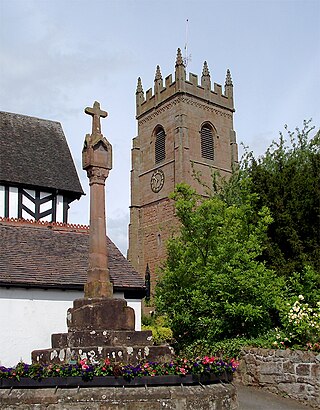
All Saints Church is in the village of Claverley, Shropshire, England. It is an active Anglican parish church in the deanery of Bridgnorth, the archdeaconry of Ludlow, and the diocese of Hereford. Its benefice is united with that of Holy Innocents, Tuck Hill. The church is recorded in the National Heritage List for England as a designated Grade I listed building.
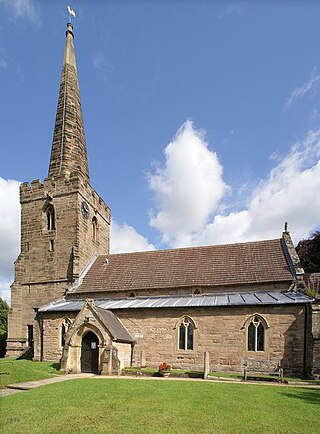
Holy Cross Church is a Grade I listed parish church in the Church of England at Epperstone in the Diocese of Southwell and Nottingham.

St Catherine of Siena Church is an Anglican parish church in Cocking, a village in the district of Chichester, one of seven local government districts in the English county of West Sussex.

St Robert's Church, Pannal, North Yorkshire, England, also known as St Robert of Knaresborough Parish Church, is a Grade II* listed building. A 13th-century wooden church dedicated to St Michael was rebuilt in sandstone in the 14th century by monks of the Trinitarian Order from Knaresborough Priory. It was perhaps then that it was rededicated to Robert of Knaresborough. Its nave was rebuilt in the 18th century, restored in the 19th and remodelled in the 20th. Extensions were added in the 20th century. It is a parish church, and the vicar also serves the Church of St Michael and All Angels, Beckwithshaw.

The Church of Saint Mary the Virgin is the Church of England parish church of Bampton, West Oxfordshire. It is in the Archdeaconry of Dorchester in the Diocese of Oxford.























